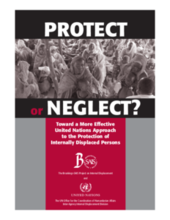Considerable and quite innovative efforts are being undertaken in a number of countries by the staff of United Nations agencies and non-governmental organizations (NGOs) to provide protection to internally displaced persons (IDPs) and other vulnerable groups, often in extremely difficult and dangerous circumstances.
In some countries, the dissemination and promotion of the Guiding Principles on Internal Displacement to national and local authorities and to UN and NGO staff have provided a clear and practical framework for protection programs and activities. These include the development of monitoring and reporting systems on the conditions of IDPs and the establishment of protection working groups to bring together UN and non-UN actors to discuss protection issues. Some UN agencies and NGOs have established presence and developed programs in areas where IDPs and people at risk of displacement are under threat.
These and other efforts notwithstanding, the survey team found that ten years after Rwanda, the United Nations had still not adopted the protection of civilians and the prevention of displacement as a core part of its mandate. The UN’s approach to the protection of internally displaced persons is still largely ad hoc and driven more by the personalities and convictions of individuals on the ground than by an institutional, system-wide agenda. It also suffers from a lack of political and financial support from UN headquarters and UN member states.
©The Brookings-SAIS Project on Internal Displacement and The United Nations Office of Humanitarian Affairs

